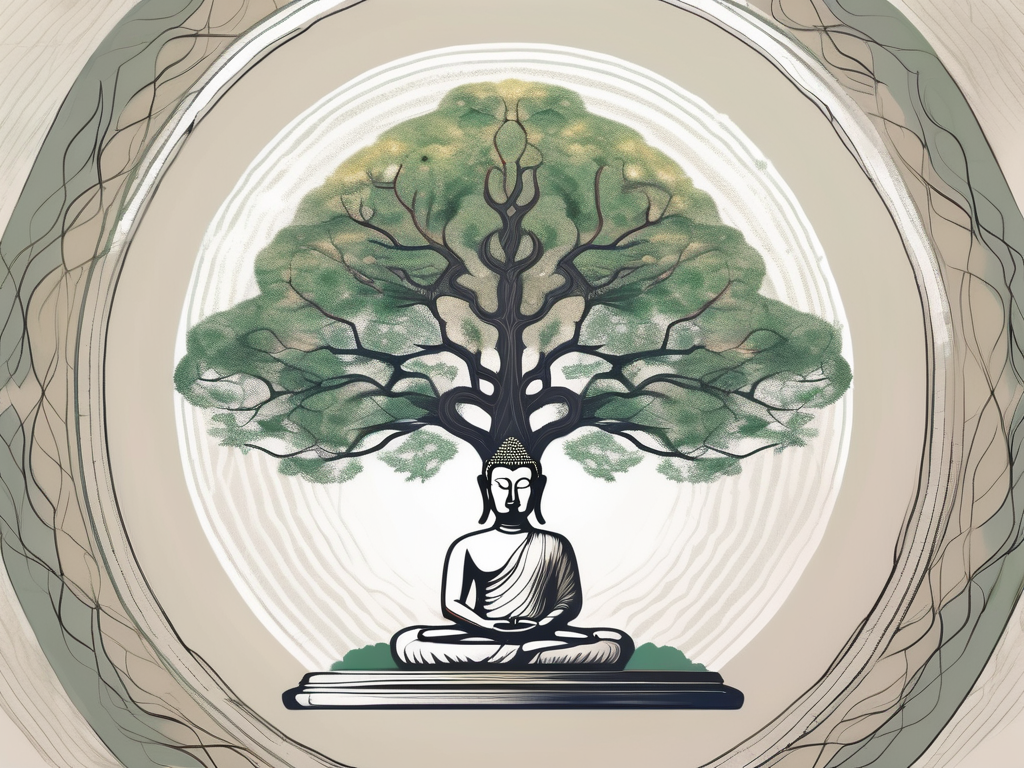Buddhism is a religion that has captivated the minds and hearts of millions of people around the world. Its origins date back thousands of years, and its teachings continue to inspire and guide individuals in their quest for enlightenment. In this article, we will take a deep dive into the ancient roots of Buddhism, exploring its core beliefs, tracing its birth, and examining its impact on ancient civilizations.
Understanding Buddhism: A Brief Overview
Before we embark on our journey to unveil the ancient roots of Buddhism, it is essential to have a basic understanding of this profound philosophy. Buddhism, founded by Siddhartha Gautama, also known as the Buddha, emerged in ancient India around the 5th century BCE. At its core, Buddhism revolves around the concept of achieving enlightenment or “nirvana” through self-realization and the pursuit of moral principles.
But what led Siddhartha Gautama to embark on this spiritual quest? Born into a life of luxury and privilege, Siddhartha was shielded from the harsh realities of the world. However, a chance encounter with suffering and death outside the palace walls shattered his illusion of a perfect existence. Determined to find a solution to the universal problem of suffering, Siddhartha renounced his princely life and embarked on a journey of self-discovery.
For six years, Siddhartha immersed himself in various spiritual practices, seeking answers from renowned teachers and ascetics. However, none of these paths provided him with the ultimate truth he sought. It was only when Siddhartha sat beneath the Bodhi tree, vowing not to rise until he found enlightenment, that he finally achieved his goal. This moment of awakening marked the birth of Buddhism.
The Core Beliefs and Practices of Buddhism
Buddhism encompasses a set of core beliefs and practices that guide its followers on the path to enlightenment. These include the Four Noble Truths, which acknowledge the existence of suffering, its causes, its transcendence, and the Eightfold Path, which serves as a roadmap to liberation from suffering.
The Four Noble Truths provide a profound insight into the nature of existence. They teach us that suffering is an inherent part of life, caused by our attachments and desires. However, they also offer hope by revealing that suffering can be transcended through the cessation of craving and the attainment of enlightenment.
The Eightfold Path, on the other hand, offers practical guidance on how to live a virtuous and meaningful life. It consists of eight interconnected principles, including right understanding, right intention, right speech, right action, right livelihood, right effort, right mindfulness, and right concentration. By following this path, individuals cultivate wisdom, ethical conduct, and mental discipline, paving the way to liberation.
Additionally, Buddhism emphasizes the practice of mindfulness, meditation, and cultivating compassion towards all living beings. By training the mind to be fully present in the present moment, individuals can develop a deep awareness of their thoughts, emotions, and sensations. This practice not only helps in achieving inner peace but also fosters empathy and kindness towards others.
The Significance of Buddhism in Today’s World
As we delve into the ancient origins of Buddhism, it is crucial to reflect upon its influence in today’s modern world. Buddhism has transcended cultural boundaries, spreading across continents and integrating into various societies. Its teachings inspire individuals to lead virtuous lives based on compassion, mindfulness, and self-discovery.
In the face of the challenges and complexities of the modern world, Buddhism offers a timeless wisdom that resonates with people from all walks of life. Its emphasis on inner transformation, ethical conduct, and interconnectedness provides a guiding light in navigating the complexities of the 21st century.
Moreover, Buddhism’s teachings on mindfulness and meditation have gained significant recognition in the fields of psychology and neuroscience. Scientific research has shown that these practices can enhance mental well-being, reduce stress, and improve cognitive abilities. As a result, mindfulness-based interventions have become increasingly popular in therapeutic settings, helping individuals find balance and resilience in the face of life’s challenges.
Furthermore, Buddhism’s emphasis on compassion and social justice has led to the emergence of engaged Buddhism, a movement that seeks to address societal issues such as poverty, inequality, and environmental degradation. Engaged Buddhists actively work towards creating a more just and compassionate world, embodying the teachings of the Buddha in their actions.
In conclusion, Buddhism’s ancient roots continue to flourish in the modern world, offering profound insights and practical guidance for those seeking inner peace, wisdom, and a more compassionate society. By understanding the core beliefs and practices of Buddhism, we can embark on our own journey of self-discovery and contribute to the well-being of ourselves and others.
Tracing the Birth of Buddhism
Now, let us travel back in time and explore the birth of Buddhism, starting with the life of its founder, Siddhartha Gautama.
The Life of Siddhartha Gautama: The First Buddha
Siddhartha Gautama, born into a noble family in ancient India, lived a life of luxury and privilege. He grew up surrounded by opulence, shielded from the harsh realities of the world. However, despite his privileged existence, Siddhartha became increasingly aware of the suffering and impermanence that plagued humanity. The walls of his palace could not shield him from the cries of pain and the inevitability of death.
Driven by an insatiable curiosity and a deep compassion for his fellow beings, Siddhartha made a momentous decision. He renounced his princely comforts and embarked on a profound journey in search of truth. Leaving behind his family, wealth, and status, he set out into the unknown, determined to find answers to the fundamental questions of existence.
For years, Siddhartha wandered through forests and villages, seeking guidance from renowned spiritual teachers and engaging in rigorous ascetic practices. He subjected himself to extreme physical hardships, believing that self-mortification would lead him closer to enlightenment. However, despite his unwavering determination, Siddhartha found that extreme austerity did not hold the key to liberation.
One fateful day, Siddhartha sat beneath the shade of a majestic Bodhi tree, vowing not to rise until he had found the truth he sought. As the hours turned into days, and days into weeks, Siddhartha delved deep into his own consciousness, confronting his fears, desires, and attachments. And then, in a moment of profound clarity, he attained enlightenment, becoming the Buddha, meaning “the awakened one.”
Having achieved the ultimate state of awakening, the Buddha realized that his purpose was not only to find liberation for himself but also to guide others on the path to enlightenment. He spent the rest of his life sharing his teachings, known as the Dharma, and guiding individuals from all walks of life towards the cessation of suffering.
The Role of Ancient India in the Emergence of Buddhism
Ancient India served as the fertile ground for the birth and development of Buddhism. It was a land where various philosophical and spiritual ideas flourished, providing the perfect backdrop for Siddhartha Gautama’s quest for enlightenment.
The ancient Indian subcontinent was a melting pot of diverse cultures, traditions, and religious practices. It was a time of intellectual ferment, where thinkers, philosophers, and spiritual seekers engaged in profound debates and discussions. The prevailing religious and philosophical systems, such as Hinduism and Jainism, offered different paths to salvation, each with its own set of rituals and practices.
Against this backdrop, Buddhism emerged as a radical departure from the prevailing religious norms. It resonated with the prevalent beliefs and practices of ancient Indians, offering a path to liberation from suffering through self-realization. The Buddha’s teachings emphasized the importance of understanding the nature of suffering, the impermanence of existence, and the role of one’s own actions in shaping their destiny.
As the Buddha traveled across the Indian subcontinent, his teachings gained popularity, attracting disciples from diverse social backgrounds. His message of compassion, mindfulness, and non-violence struck a chord with people from all walks of life. The Buddha’s teachings challenged the rigid caste system and the rituals associated with it, offering a more egalitarian and inclusive approach to spiritual awakening.
Over time, Buddhism became a prominent force in ancient India, with monastic communities flourishing and Buddhist art and architecture leaving an indelible mark on the landscape. The birth of Buddhism in ancient India not only transformed the religious and philosophical landscape of the subcontinent but also had a profound impact on the development of other spiritual traditions that followed.
The Spread of Buddhism: From India to the World
As Buddhism gained momentum, it transcended geographical boundaries, reaching far beyond the Indian subcontinent. Let us now explore how it ventured westward along the Silk Road and expanded its influence in East Asia.
Buddhism and the Silk Road: A Journey Westward
The Silk Road, an ancient trade route connecting East and West, played a significant role in the spread of Buddhism beyond India. Traders, pilgrims, and scholars journeyed along this route, carrying Buddhist teachings, scriptures, and artistic influences to regions as far as Central Asia, the Middle East, and even Europe.
Buddhism’s encounter with different cultures along the Silk Road led to the emergence of unique expressions of the philosophy, shaping Buddhist art, architecture, and practices in these diverse regions.
The Influence of Buddhism in East Asia
In East Asia, Buddhism underwent further transformations, adapting to the cultural, philosophical, and religious traditions of countries such as China, Japan, and Korea. It blended with Confucianism, Taoism, and indigenous practices, giving rise to distinct branches of Buddhism, such as Zen and Pure Land Buddhism.
The impact of Buddhism in East Asia extended beyond religious practices, permeating various aspects of society, including art, literature, governance, and even everyday life. Its teachings of compassion, mindfulness, and the pursuit of wisdom continue to resonate with millions in the region.
The Evolution of Buddhist Thought
As Buddhism spread to different parts of the world, it underwent an evolution, giving rise to different schools of thought. Let us explore the development of Theravada and Mahayana Buddhism, as well as the emergence of Zen Buddhism.
The Development of Theravada and Mahayana Buddhism
Theravada and Mahayana are two major branches of Buddhism that emerged during this evolutionary phase. Theravada Buddhism, known as the “Doctrine of the Elders,” adheres closely to the original teachings of the Buddha and emphasizes individual liberation through self-effort and meditation.
In contrast, Mahayana Buddhism, meaning the “Great Vehicle,” places greater emphasis on compassion and the liberation of all beings. It encompasses a vast range of practices and beliefs, offering a more accessible and inclusive path to enlightenment.
The Emergence of Zen Buddhism
Zen Buddhism, a branch of Mahayana Buddhism, gained popularity in East Asia, particularly in Japan. Zen emphasizes direct experience and the practice of meditation to achieve sudden enlightenment. Its simplicity and focus on the here and now have resonated deeply with those seeking a direct path to enlightenment.
The Impact of Buddhism on Ancient Civilizations
Beyond its spiritual teachings, Buddhism had a profound impact on the societies and civilizations it encountered. Let us delve into Buddhism’s influence on ancient Indian kingdoms and its lasting imprint on Chinese philosophy.
Buddhism and the Ancient Kingdoms of India
In ancient India, Buddhism influenced not only the spiritual landscape but also political and social realms. Buddhist principles played a significant role in shaping the governance, art, and education systems of prominent Indian kingdoms such as the Mauryas, the Guptas, and the Pala Empire.
Buddhist universities, such as Nalanda and Vikramashila, attracted scholars from far and wide, fostering intellectual pursuits and contributing to the development of various branches of knowledge.
Buddhism’s Influence on Ancient Chinese Philosophy
When Buddhism reached China, it encountered ancient philosophies such as Confucianism and Taoism. The encounter between these philosophical traditions gave rise to new schools of thought, such as Neo-Confucianism, which incorporated Buddhist ideas and practices into Chinese cultural and intellectual spheres.
Buddhism’s emphasis on introspection, self-realization, and the pursuit of spiritual awakening left an indelible mark on Chinese philosophy, influencing thinkers such as Zhu Xi and Wang Yangming.
In conclusion, the ancient roots of Buddhism hold a rich tapestry of knowledge, wisdom, and spiritual insights. From its humble origins in ancient India to its spread across the world, Buddhism has shaped the lives of countless individuals and left an enduring legacy in the realms of spirituality, philosophy, and culture. Its teachings continue to inspire seekers of truth, offering a path to liberation from suffering and the attainment of enlightenment.












